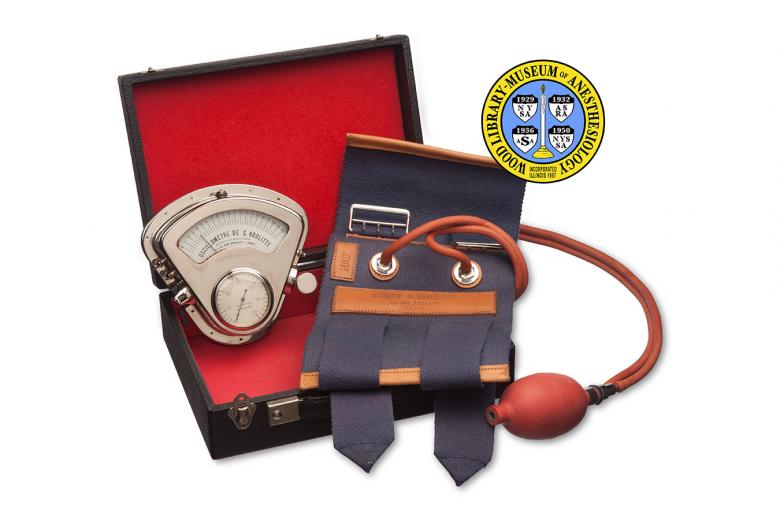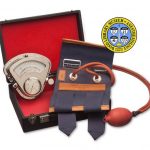Pachon Oscillometer
The patient’s blood pressure is one of the variables monitored by anesthesiologists during anesthesia. An oscillometer of the kind pictured here is an instrument that measures the oscillations (fluctuations) of blood pressure, or the force of the blood against the walls of an artery as the heart repeatedly contracts and relaxes. The French physician, Michel Victor Pachon (1867-1938) introduced his sphygmographic oscillometer in 1909. This one was manufactured by the French company, G. Boulitte, around 1930.
The oscillations of pressure in the artery under the cuff were transferred to an aneroid capsule in the airtight housing of the metal oscillometer. It had two scales: one for reading the amplitude of oscillations and the other for determining the blood pressure. The scale for blood pressure is marked in centimeters of mercury; today’s sphygmomanometers are marked in millimeters. To use it, the valves had to be opened and closed rapidly and repeatedly, making its accuracy variable.
The cuff employed with this oscillometer was designed by the highly respected French cardiologist Louis Gallavardin (1875-1957). Among his contributions was an extensive study of the physiology of blood pressure. His blood pressure cuff incorporated two independently inflated rubber bladders, one overlapping the other. Oscillometers of this type were found to provide more accurate readings when used with a similar cuff.
Catalog Record: Pachon Oscillometer
Access Key: akhs
Accession No.: 2001-01-21-1
Title: Oscillomètre de G. Boulitte.
Author: Pachon, Victor, 1867-1938.
Author: Gallavardin, Louis, 1875-1957.
Corporate Author: G. Boulitte.
Title variation: Alt Title
Title: Pachon oscillomètre.
Title variation: Alt Title
Title: Pachon’s oscillometer.
Title variation: Alt Title
Title: Oscillometer made by G. Boulitte.
Title variation: Alt Title
Title: Oscillomètre universel nouveau modèle.
Publisher: Paris : G. Boulitte, [1922-1940].
Physical Descript 1 oscillometer : metals, rubber, textile, glass, leather ; 8 x 25 x 19.5 cm.
Subject: Oscillometry – instrumentation.
Subject: Blood Pressure Determination – instrumentation.
Subject: Blood Pressure Monitors.
Note Type: General
Notes: The earlier year in the date range for the possible year of manufacture is
based on the year that Gallavardin described his design for a double-bladder
brachial cuff (1922). The late date is based on information about the
manufacturer and the physical condition of the object. The date range could
change if documentation indicates the range should be corrected.
Note Type: Citation
Notes: Barry CT. Oscillometry during anaesthesia. Anaesthesia. 1950;5(1):26-35.
Note Type: Citation
Notes: Bedford DE. Louis Gallavardin. Br Heart J. 1958;20(3):299–301.
Note Type: Citation
Notes: Kapse CD, Patil BR. Auscultatory and oscillometric methods of blood pressure
measurement: a survey. Int J Eng Res Appl. 2013:3(2):531. https://www.ijera.
com/papers/Vol3_issue2/CI32528533.pdf. Accessed July 12, 2013.
Note Type: Citation
Notes: Larocque C. Blood pressure with Pachon’s oscillometer. Anesth Analg.
1927:6(3):125-130.
Note Type: Citation
Notes: Watson-Wemyss HL. On the use of the sphygmoscillometer of Pachon. Br Med J.
December 2, 2011;2(2657):1472.
Note Type: Citation
Notes: Wilber CK. Antique Medical Instruments. 5th ed. Atglen, PA: Schiffer
Publishing Ltd.; 2003:35.
Note Type: Physical Description
Notes: One leather covered wood box with two hinges, two latches and a carrying
handle; The inner side of the top-half of the box is lined in red felt and
the inner bottom and sides of the bottom-half of the box is lined with a red
textile; There are no markings on the box; The box contains a triangular
shaped oscillometer, a blood pressure cuff, and red rubber tubing and
inflation bulb; The oscillometer houses two scales; Markings below the upper
scale include, “OSCILLOMÈTRE DE G. BOULITTE [new line] BREVETÉ S.G.D.G.
MODÈLE DÉPOSÈ [new line] 15 à 21, RUE BOBILLOT – PARIS”; The upper, curved
scale is marked in half increments with the whole increments numbered from 0
to 20; The lower, circular scale is marked in increments of one with every
fifth increment numbered from 0 to 30; Marked in the lower scale is,
“CENTIMETRES DE MERCURE”; On the left side of the oscillometer is a dial that
can be turned to “MN”, “MX”, or “PU”; Behind this dial on the left are two
port for the two rubber tubes that connect to the cuff’s bladders; On the
right is a turn knob; Behind the turn knob is a port for the rubber tube that
connects to the inflation valve; The cuff is made of a thick, blue canvas
with leather labels and leather finished ends; Markings embossed into the
leather labels includes, “OSCILLOMÈTRE UNIVERSEL DE G. BOULITTE BREVETÉ S.G.
D.G.”, “HAUT”, “ETABTS G. BOULITTE 15. RUE BOBILLOT – PARIS-“; Two buckled
straps are sewn into the cuff to hold the cuff in place; With the straps, the
cuff measures approximately 54 cm long and 16 cm wide; Metal connectors for
the two rubber tubes that connect the cuff with the oscillometer exit the
exterior of the cuff; on the inside of the cuff are two rubber bladders; One
slightly overlaps the other; One bladder measures approximately 24 cm in
length and 9 cm wide, and the other measures approximately 24 cm long and 7
cm wide; A red rubber inflation bulb with metal connections for tubing
measures approximately 14 cm in length (metal port included) and 5 cm at its
widest diameter; There is no tube to connect the bulb to the oscillometer.
Note Type: Reproduction
Notes: Photographed by Mr. Steve Donisch on January 15, 2013.
Note Type: Historical
Notes: An oscillometer of the kind described in this record is an instrument that
measures the oscillations (fluctuations) of blood pressure, or the pressure
of the blood against the walls of an artery as the heart repeatedly contracts
and relaxes. This oscillometer manufactured by the French company G. Boulitte
was made after one designed by French physiologist Victor Pachon (1867-1938)
around 1909. The oscillations of pressure in the artery under the cuff are
transferred via tubing to an aneroid capsule in the airtight metallic housing
of the oscillometer, which amplifies the oscillations in a way that enable
fine readings of the pressure changes. Pachon’s oscillometer had two scales:
one for reading the amplitude of oscillations and the other for determining
the blood pressure. The scale in this oscillometer is marked in centimeters
of mercury, as opposed to the millimeters of mercury that is used today.
Note Type: Historical
Notes: Used with this oscillometer was a cuff designed by the highly respected
French cardiologist Dr. Louis Gallavardin (1875-1957). Among his
contributions was his extensive study of the physiology of blood pressure.
His blood pressure cuff incorporated two independently inflated rubber
bladders, one overlapping the other. Pachon-like oscillometers were found to
provide more accurate readings when used with Gallavardin-like cuffs, rather
than the cuff designed by Pachon.
Note Type: Historical
Notes: The patient’s blood pressure is one of the variables monitored by
anesthesiologists during anesthesia and surgery. Anesthesiologists Charles
LaRocque in 1927 and C.T. Barry in 1950 published papers on the Pachon
oscillometer and its useful applications, such as the device’s sensitivity
and ability to obtain blood pressure readings that are too low to hear via
the auscultatory method. Present-day automated blood pressure monitors use
the oscillometric method to provide digital readings.
Note Type: Publication
Notes: Acierno LJ. Louis Gallavardin. Clin Cardiol. 1999;22(1):52-53.
Note Type: Publication
Notes: Gallavardin L. Sur un nouveau brassard sphygmomanomètrique. Presse Med.
September 9, 1922;30(72):776-777
Note Type: Publication
Notes: Halls Dally JF. Pachon’s sphygmo-oscillometer and its use in the
determination of blood pressure, with notes on the theory of oscillations.
Lancet. September 2, 1911;178(4592):680-682.
Note Type: Publication
Notes: Pachon, V.: Oscillomètre sphygmométrique à grande sensibilité et à
sensibilité Constante. Compt Rend Soc de Biol. 1909;66:776.
Note Type: Exhibition
Notes: Chosen for the WLM website (noted June 10, 2013).


